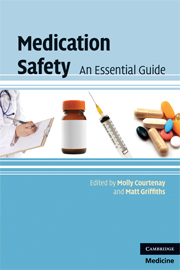Book contents
- Frontmatter
- Contents
- List of contributors
- Preface
- 1 Introduction to medication errors and medication safety
- 2 Safety in prescribing
- 3 Safety in dispensing
- 4 Safety in administering
- 5 Adverse drug reactions and drug interactions
- 6 Interface of care and communication
- 7 Parenteral drug administration
- 8 Calculations
- 9 Controlled drugs and patient safety
- 10 Reporting medication errors and near misses
- 11 Ensuring safety through evidence-based medicine
- Index
Preface
Published online by Cambridge University Press: 22 January 2010
- Frontmatter
- Contents
- List of contributors
- Preface
- 1 Introduction to medication errors and medication safety
- 2 Safety in prescribing
- 3 Safety in dispensing
- 4 Safety in administering
- 5 Adverse drug reactions and drug interactions
- 6 Interface of care and communication
- 7 Parenteral drug administration
- 8 Calculations
- 9 Controlled drugs and patient safety
- 10 Reporting medication errors and near misses
- 11 Ensuring safety through evidence-based medicine
- Index
Summary
Non-medical prescribing is a new area of practice for nurses, pharmacists and allied health professionals (AHPS). Over 30000 district nurses and health visitors are able to prescribe from the Nurse Prescribers Formulary (NPF) for Community Practitioners. More than 14000 nurses and 1500 pharmacists across the United Kingdom (UK) have virtually the same independent prescribing rights as doctors. Several hundred AHPs (i.e. physiotherapists, podiatrists, chiropodists and radiologists) and optometrists are able to prescribe in partnership with doctors. These figures are set to rise.
Errors surrounding the prescription, administration and dispensing of medicines by healthcare professionals account for a significant amount of harm and even deaths across the UK. Twenty per cent of all critical incidents in the National Health Service (NHS) are caused by medication errors. These errors cost the NHS as much as it would cost to fund two acute teaching hospitals. The reduction of prescribing errors is now a major Government initiative. This timely and much needed text is designed for all healthcare professionals involved in the management of medicines.
Chapter 1, introduction, provides a general overview of medication safety, the different mechanisms available to healthcare professionals to deliver medicines to patients and actions that can be taken to improve medication safety. Chapters 2 to 4 examine safety in prescribing, safety in dispensing and safety in administering. Adverse drug reactions and drug interactions, interface of care and communication and parenteral drug administration, are explored in Chapters 5 to 7.
- Type
- Chapter
- Information
- Medication SafetyAn Essential Guide, pp. ix - xPublisher: Cambridge University PressPrint publication year: 2009

